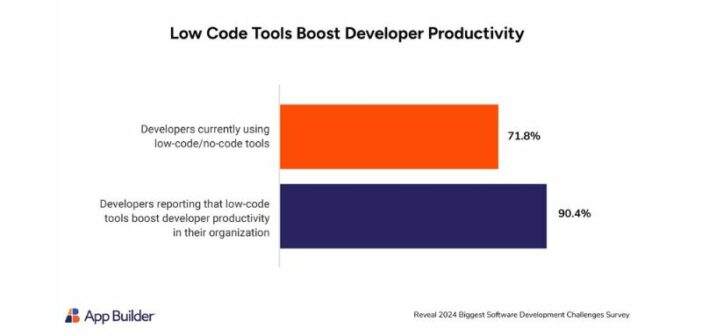According to the 2024 Reveal Biggest Software Development Challenges survey, low-code software has emerged as a significant advancement, proving to be a potent force in expediting app development and enhancing productivity. The survey, encompassing 585 respondents, revealed that nearly all participants (90.4%) reported increased developer productivity through the use of low-code tools. Furthermore, a majority (43.5%) of developers reported saving up to half of their time when employing low-code tools on projects.
“Low-code software has real value in democratizing software development to include non-developers,” says Jason Beres, Senior VP of Developer Tools at Infragistics, and creator of App Builder software. “It puts users in control of application development and empowers teams to develop and modify applications using intuitive tools without coding expertise. The global shortage of skilled software developers drove the implementation of low-code software for non-programmers and has resulted in improved efficiency.”
The survey found that building apps significantly consumes development resources, with 28.2% of developer’s time dedicated to coding and 24.8% to design. This marks progress from 2023, where coding alone accounted for 43.4% of their time.
Low-code tools make it easier to create apps without a designer or design team. Nearly half of respondents (47.2%) work with a designer in 2024 compared to 88.8% who worked with a designer in 2023.
The Market for Low-Code Tools is Exploding
Low-code platforms like App Builder have surged in popularity, due to their ability to simplify app creation for business and technical users, thereby saving time and money. The 2024 Reveal survey reports that two-thirds (71.8%) of developers are now using low-code/no-code tools. Additionally, more than half (56.4%) anticipate greater reliance on these tools in 2024. Nearly one in three developers (28%) aim to adopt low-code/no-code tools within the year and 26.7% seek software suitable for citizen developers.
In addition, a third (33.5%) of respondents plan to implement designer/developer collaboration tools.
“Strained technology budgets, a shortage of developers and the pressure to work efficiently and deliver better services have fueled the low-code boom,” says Beres. “Companies are realizing that if they streamline their low-code stack, they can achieve cost reductions, enhance business resilience, and better adapt to a rapidly changing competitive landscape.”
According to KPMG, “Analysts predict that low code will become the preferred software development method by 2025. Gartner expects the market to grow to almost $30 billion by then, with a compound annual growth rate of 20 percent. Clearly, the industry has great expectations for low code adoption and utilization. For now, companies are deciding how to transition from selective low code adoption to the cohesive, enterprise-wide approach that would drive these lofty growth expectations.”
One of the most significant benefits of adding low-code tools to your tech stack is that they bridge the gap between design and development, offering pre-designed templates and drag-and-drop interfaces. In an age of developer shortages and overworked programmers, low-code software not only increases productivity, but it also improves organizational efficiency, overcomes development backlogs, reduces costs, and uses fewer resources. The rise of low-code/no-code platforms is shaking up the world of software development – not by replacing traditional programmers but by expanding the toolkits available to software developers and enhancing their productivity. Learn more about low-code software as a significant advancement in the App Builder report.
Survey Methodology
A total of 585 software developers and IT professionals participated in Reveal’s fifth annual survey from December 2023 to January 2024.
Related News:
Top Software Development Challenges in 2024 Will be AI Integration

